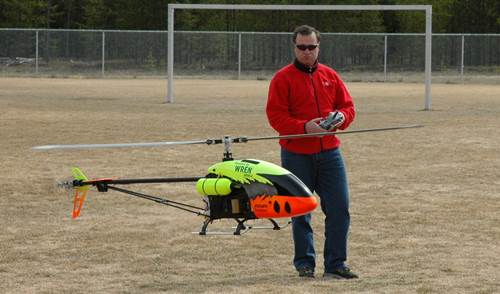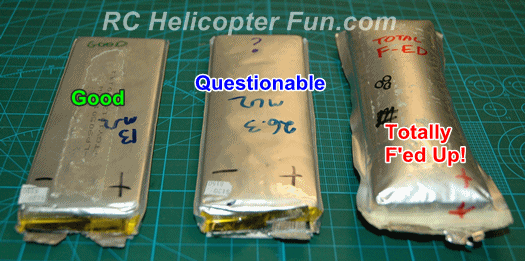DFC / Driverless Rotor Heads Demystified
by John Salt Last Updated April 2025
So what exactly is a DFC (direct flight control) or Driverless rotor head? Is it the same thing as flybarless? What are the pros & cons vs. a conventional washout? Does it work better with some helicopters over others?
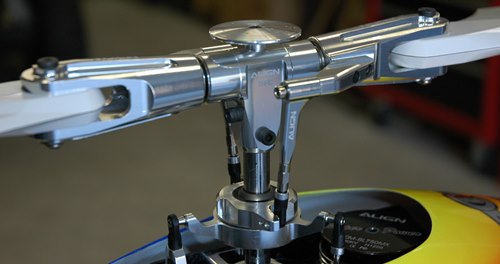 Trex 800E DFC Rotor Head
Trex 800E DFC Rotor HeadThere seems to be a fair amount of misunderstanding, at least going by some of the email questions I get along with comments on my YouTube channel regarding direct flight control / driverless heads.
Perhaps the biggest one I get asked is if a DFC rotor head is better than a flybarless rotor head?
Well, DFC & flybarless are two entirely different things. It's like asking if a tire is better than 4 wheel drive.
Flybarless is a type of rotor head & stabilization system - click that link if you want to learn about flybarless.
DFC on the other hand is a mechanically simplified flybarless rotor head linkage system that does away with the washout (also known as the swash driver).
In other words, all DFC heads are flybarless, but not all flybarless heads are DFC. Clear as mud right!?
Let's start by looking at a conventional flybarless rotor head with a washout / swashplate driver and that way it will be easy to spot the difference between these two types of flybarless rotor head designs.
Conventional Swashplate Driver
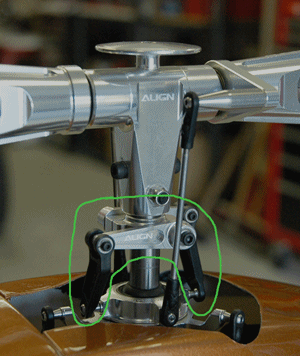 Conventional Flybarless/Bell Rotor head with washout arms & radius arm links.
Conventional Flybarless/Bell Rotor head with washout arms & radius arm links.The photo to the right is showing a conventional Flybarless (FBL for short) rotor head with the washout base, washout arms, and black radius arms all circled in green.
The sole purpose of the washout assembly is to rotate the top half of the swashplate with the head so it remains properly phased with the rotor head while still allowing the full range of up/down & tilting movement/articulation of the swashplate.
The washout base can be clamped to the mast (as shown above) or it can be integrated into the bottom of the rotor head.
As the mast or head turns, the rotational loads are transmitted to the washout arms and then to the radius arms, which are then connected to two balls on the upper swash. This is why this part is also called the swashplate driver or swashplate follower as it drives and allows the swashplate to "follow" and keep in phase with the rotor head.
Please take note however in that above photo, that the main rotor grip pushrods still do attach directly from the upper swash balls to the blade grip control arm balls by way of a ball link on each end.
They still provide a direct linkage between the swashplate and the blade grips - no more or no less so than a DFC linkage.
In other words, D-F-C is misleading in what it really does, but the majority of the industry has adopted/copied the acronym. Even "driverless head" is fundamentally incorrect because the swashplate is still being driven, just not by the washout arms. Washout-less is a more accurate description.
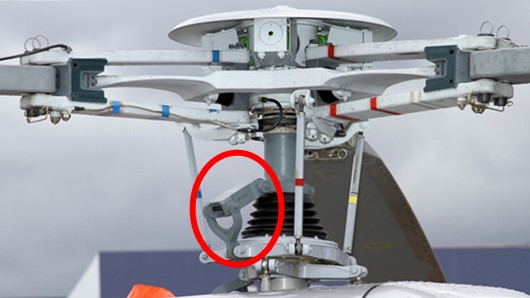 Full Size Helicopter Swashplate Driver
Full Size Helicopter Swashplate DriverIncidentally, all full size helicopters (at least every one I've ever seen & flown in), also use swashplate drivers as can be seen on this AS350 rotor head. The swash driver is circled in red. Most full size helicopters only use a single washout linkage. Most RC helicopters use a dual washout, but some large scale RC helicopters will use a single swashplate driver for more scale realism.
DFC Swashplate Driver
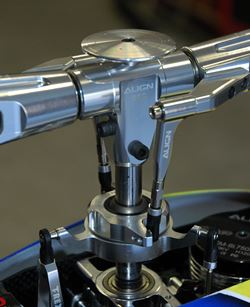 DFC Head
DFC HeadNow let's look at a direct flight control rotor head.
Notice there is no washout/swash driver on this rotor mast. The blade grip pushrods have been replaced with a much beefier control linkage that is integrated directly into the blade grip arm.
This design now allows the stronger DFC linkage to transmit the rotational/lateral loads down to the upper half of the swashplate to keep it spinning & phased with the rotor head the same way the washout would.
The main advantage is easy to spot - less parts count. It also looks great in my opinion!
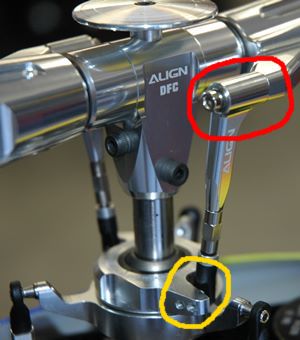 DFC Head Linkage
DFC Head LinkageI have circled (in red) the main design feature that all driverless/direct flight control head designs share.
This is the main component difference over a simple ball link.
This linkage can rotate on the blade grip arm axle still allowing the blade grips to change pitch angle, but it can't pivot like a ball link could and that is what allows it to transmit lateral force down to the swashplate to "drive it".
These DFC arm axles will usually have two ball bearings, but some small RC helicopters use a simple bushing.
In yellow I have circled the other end of the linkage which still uses a conventional ball link as there has to still be some sort of fully articulated pivot point. You will notice the swashplate (in this particular example) has ears extending at a 90 degree angle to the swash where the ball link attaches to the ball.
The proposed advantage to the "swash ear" design is that it's very unlikely a link will pop off under combined prying and centripetal loading. This leads us to direct flight control drawbacks and potential issues; it all comes down to avoiding head axle feathering movement at all costs (in other words, little to no head dampening).
DFC - The Potential Issues
Before going into this, have a look at the video below to get a better understanding of the mechanics involved with a direct flight control head if super stiff dampening is not used or if any play develops in the head axle shaft supports and is allowed to feather up and down.
As you can see, any feathering movement of the head axle will tilt the integrated control linkage and that will put large amounts of strain on the linkage itself, the linkage bearings/bushings, the bolt or pin where it attaches to the grip arm, the ball links down at the swashplate, the swashplate, and even down to the servos.
Keep in mind that is while performing a static/stationary demonstration. The dynamic stresses during flight are even more severe.
In effect, the blade grip control linkage has now become a very formidable pry-bar. This "prying" action also throws the swash phasing out slightly depending on how much the axle shaft is allowed to pivot, length of the DFC linkages, and how far away the blade grips are from the mast center line of the head. In general, the bigger the helicopter the larger the movement & prying force.
These excess lateral / "prying" forces on the linkage arm in combination with centripetal forces pulling on larger, higher mass linkages is what can lead to ball link separation down at the swashplate.
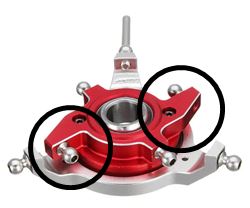 Right Angle Ears on DFC Specific Swashplate
Right Angle Ears on DFC Specific SwashplateThat was the main reason Align & SAB went with those updated swashplates with the swash ears with right angle ball placement to reduce the possibility of centripetal separation.
Regardless, the main thing to keep in mind is head axle movement is the DFC KILLER and must be avoided at all costs.
The larger the heli, the more of an issue this is and is why all the big name manufacturers have gone back to washouts on their larger helicopters - there were just too many issues.
Most direct flight control heads on larger RC helicopters used very stiff head dampeners (basically not far off an un-dampened/rigid setup) to keep axle feathering movement at the bare minimum, but still allow a base level of blade vibration absorption.
Non Rigid Driverless Heads
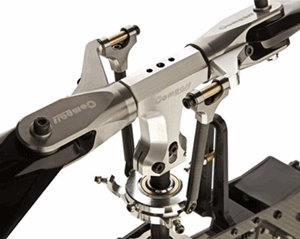 The Flexible DFC Arm Experiment
The Flexible DFC Arm ExperimentTo alleviate most of these rigid DFC issues, one manufacturer (Compass RC - now out of business) experimented with a partially flexible elastomer control linkage.
If the head axle feathered, all the prying force was no longer transmitted down the control linkage; much was absorbed within the flexible linkage itself. This not only reduced the stress loads in the linkages and attachment points, it allowed lower head speeds to be run just like with any other "conventional" dampened head. Slight phasing variation was of course still a potential problem.
All other manufacturer's DFC linkages were, and still are rigid; so checking for worn/soft dampening is always a good pre-flight procedure.
Personally, a pre-flight I always perform on my T-Rex 800 DFC is to check for any any head axle play by pulling up and down on the blade grips. No movement = good to go!
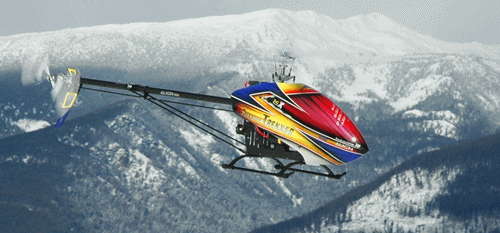 The largest DFC heli I still own - The T-Rex 800 Trekker. DFC complications are a constant concern - pre-flight checking avoids most.
The largest DFC heli I still own - The T-Rex 800 Trekker. DFC complications are a constant concern - pre-flight checking avoids most.Another reported issue I've heard with rigid direct flight control head design over the past decade is blade strikes (even minor ones), are more likely to transmit damaging forces down through the blade grips to the swashplate and into the servos.
I experienced this myself on a Trex 600E Pro DFC a number of years back when a huge gust of side wind tipped it over just after I landed as the rotors were still spooled.
I did manage to level it out, but not before the rotor tips had just kissed the ground. Very little damage was even evident on the rotor tips, the head axle was not bent, nor was the rotor shaft.
I basically brushed it off as a non event and no change of underwear was required. Then I started moving the swashplate servos around. One of them was very noisy and I found some teeth of the metal gear set torn out which takes a good deal of force.
Perhaps it was just a weird coincidence of the right set of conditions existing all at once to strip out a strong metal servo gear set with a minor tip strike, but I've had much worse impacts on 600's with conventional washouts that never once stripped out a servo and as I said, I've heard of similar DFC servo damage numerous times over the years.
With a traditional washout & pushrod setup, chances are the plastic ball links would have popped or broken off, or the pushrod's would flex or bend to absorb some of the impact energy from reaching the servo (the good old sacrificial mechanical fuse device in other words). Not so with a much stronger integrated DFC linkage.
In short, if you have a blade strike (even a very minor one) with a rigid direct flight control head, make sure you closely examine every linkage component right down to the servo arms and gears to make sure nothing is bent, cracked, or stripped (nothing new you shouldn't already be doing with any head type after a mishap).
DFC Scale Warning
If a scale fuselage is perhaps a future project on your direct flight control equipped machine; better think twice on that...
Why?
Because the rotors are sitting so much lower on most driverless heads, it may not be possible to fit a scale fuse or even if it is, it's very possible the blades will contact the scale boom which are almost always larger in diameter and may have horizontal fins with vertical side fins that will get chopped off with the slightest amount of blade flex.
Scale birds almost always run lower head speeds (not only for realism but to prevent high frequency fuselage resonance issues) and once again, running low head speeds is generally not possible with DFC on larger RC helicopters.
Before getting any comments from the peanut gallery, I'm talking about general "average Joe" scale builds here. You know, throwing a generic fuselage over a typical off the shelf DFC equipped pod & boom heli kit.
I'm not talking about super scale mechanics that are purpose built for these applications as some will use full scale multi blade driverless heads with scale grip flapping or grip flex built in.
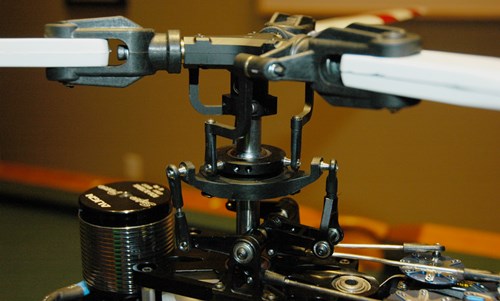 Super Scale DFC Tri-Blade Rotor Head
Super Scale DFC Tri-Blade Rotor HeadShown above for example is a 700 size Roban Compactor Super Scale Tri-Blade DFC rotor head for an AS350B. Both the blade grips and scale non-symmetrical blades have a fair amount of built in flex.
Moreover as shown below, the boom is mounted very low in the mechanics compared to most pod & booms giving more blade to boom distance (green arrow), helping avoid boom strikes.
 Scale DFC Head With Lowered Tail Boom
Scale DFC Head With Lowered Tail BoomDFC Boom Strikes?
Scale fuselages aside, having the rotors sitting lower on the heli brings us to the last negative and highly debated DFC topic - boom strikes!
As you can guess, with the rotors being closer to the tail boom, there is a greater chance & potential the rotors will contact the boom if the right set of conditions are present. With some heli's this seems to be a bigger issue than others, but it can certainly happen with any direct flight control equipped RC helicopter just as it can with any conventional flybarless head or even a flybared head if you don't pay attention to some basic boom strike rules & physics.
First off, head speeds have to be kept up at manufacturer's minimum recommend settings for the type of flying you are doing. This is pretty much a given anyways with stiff head dampening which necessitates higher head RPM's to prevent blade flutter & cyclic pitch wobbles, but it's even more critical to follow and be aware of with direct flight control, especially when performing aerobatics.
With high rotor RPM's, the blades will not flex as much under high disc loading or high negative G maneuvers because they are under higher centripetal force preventing them from bending as close to the tail boom.
Likewise, the increase in the pseudo centrifugal force will also keep the blades from leading or lagging excessively which under high collective or cyclic pitch angles means they will not be tilted down as close to the boom further minimizing catastrophic blade to boom contact.
Blade bolt torque also plays a roll here and should be kept fairly tight (depending on the size of helicopter of course) but if you find after you land and rapidly spool down, one or both of the blades is loose enough in the grips that it visually leads or lags in the blade grip, it is much more likely for that blade/s to hit the boom if the lead/lag condition is present at the same time as a large positive or negative collective pitch angle (blade/s will be angled down dangerously close to the boom).
Head dampener stiffness & condition are of course considerations when talking about boom strike prevention since a soft or worn out dampener will allow the head axle to pivot/feather up and down excessively causing the rotor blades to do the same and contact the boom if the movement is sever enough. Since I already covered the importance of dampener condition and axle play with rigid direct flight control, there is no point to go over that again but it remains something to keep a close eye on and is worth repeating.
So, boom strike causes & avoidance are more or less exactly the same as they are with a conventional flybar or flybarless head; it's just a little more critical with most DFC/driverless heads that the causes of boom strikes are understood so you know how to best avoid them.
DFC - The Good
With these potential direct flight control issues, is there anything good about it?
You bet!
I already pointed out two items earlier and that is the lower parts
count and how good it looks. In addition to that, head setup is a bit
easier because you don't have to worry about washout base height etc. to
get the washout arms level while setting head geometry (if you have a
non integrated washout).
In the case of that super scale DFC head, no swashplate phasing was needed since the DFC control links are purpose designed to correctly phase the head to the swash; but what about flight performance improvements
if any?
With super stiff
dampening used on most direct flight control heads, there is no question cyclic response is
very crisp and immediate. That said, you
can stiffen the dampening & run higher head speeds on a conventional washout type head and
basically achieve the same results so we can't say that is something
unique to a direct flight control head.
What
is unique however is the minimized helicopter body's center of mass
to rotor disc distance.
Due to the head design itself and the elimination of the washout base, the mast & head can be shortened which brings the rotor blades (rotor disc) down closer to the helicopter's center of mass. This further improves cyclic roll and flip rates and gives a more symmetrical feel between right-side up and inverted maneuvers.
Again, all that is for conventional pod & boom RC helicopters, not purpose designed scale mechanics.
Micro & Small RC Helicopters - The Big DFC Winners!
Most if not all RC helicopter manufacturers have gone away from DFC on all their larger helicopters; however, that doesn't mean the DFC experiment that Align, SAB & others started in 2012 was a complete failure.
Small and micro size RC helicopters have benefited greatly by DFC.
This is simply due to the fact that tiny washouts on micro and small helicopters are fragile, finicky, introduce added servo drag, and almost always have or will develop slop. Washout slop will cause way more swash phasing variation than DFC linkage prying forces ever will on a micro or small size RC helicopter.
All those extra washout parts also add cost and weight which is the number one enemy on all small RC helicopters.
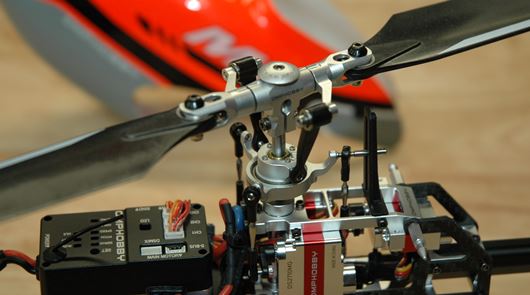 Small 200 Size Heli Benefits Greatly From A DFC Head Linkage System
Small 200 Size Heli Benefits Greatly From A DFC Head Linkage SystemAs seen above on this small 200 size RC helicopter, DFC is an elegant and simple solution to all those issues. Meanwhile all the problems with DFC on larger RC helicopters are pretty much non-existent or inconsequential on smaller ones.
So while I and many others may not like DFC on our larger RC helicopters, most of us really enjoy their many small size specific benefits.
By the way... if you're wondering what my rule of thumb size cut off is for DFC; it's pretty much the same as my size cut off for fixed pitch, brushless direct drive tail motors... About 300 size and larger would have the many DFC compromises swing in washout's favor.
Hope that helps clear up what DFC is, its pros & con's, and what type of RC helicopters it works best on. Happy Flights! :)







